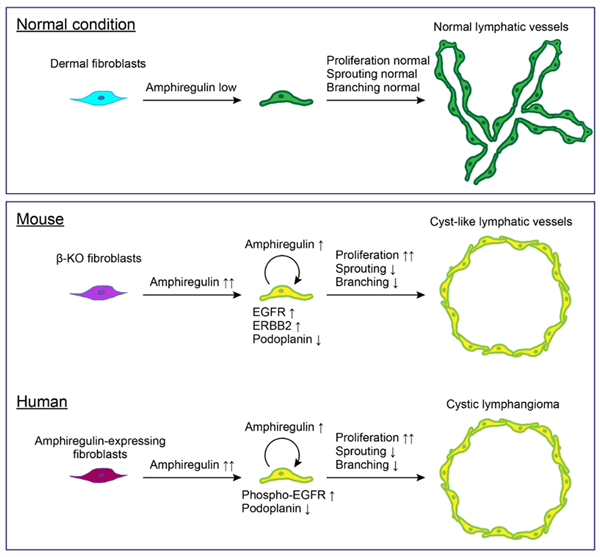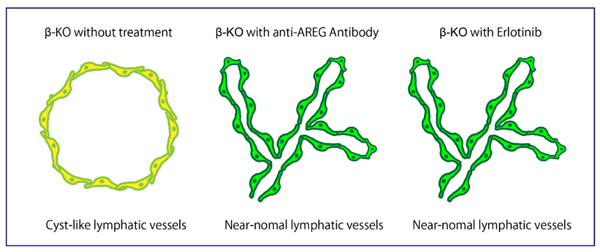Elucidating the mechanism of development and progression of cystic lymphangioma.
Lymphatic vessels play an important role in the collection of tissue fluid and the immune cell recruitment. In the pathological condition of lymphatic vessels, cystic lymphangioma has been known as congenital abnormalities of lymphatic malformations. Cystic lymphangioma occurs mainly in children and exhibits large lymphatic cysts. The pathobiology is benign; however, large cysts in the neck can be compressing the airways. In addition, large cysts observed around the head, face and neck are the emotional burden on patients and their families due to their appearance problem.
The molecular mechanisms of the progression of cystic lymphangioma are unknown. The treatment options are surgical resection and sclerotherapy. However, depending on the lesion, such as head, face and neck, these treatments may not be applicable. In addition, these treatments are sometimes ineffective, because they are not based on the molecular mechanisms of cystic lymphangioma. For these reasons, it is really needed that the development of therapeutic agents that are based on molecular mechanisms of pathogenesis and progression.
We have developed a mouse lymphangiogenesis model and applied it to PDGFRβ conditional knockout (β-KO) mouse. β-KO mouse showed cyst-like lymphatic vessels which was appeared to reproduce the cystic lymphangioma pathology. By using the mouse, we examined underlying molecular mechanisms of progression of cyst-like lymphatic vessels. Eventually Amphiregulin was found as a candidate molecule, that is highly expressed in fibroblasts in the vicinity of cyst-like lymphatic vessels.
Next, we analyzed the expression of Amphiregulin in human cystic lymphangioma samples and found that Amphiregulin was highly expressed in fibroblasts surrounding the cystic lymphatic vessels. Interestingly, the lymphatic endothelial cells themselves also highly expressed Amphiregulin in the specimens from cystic lymphangioma. Co-culture of β-KO fibroblasts with human lymphatic endothelial cells resulted in a significant increase in the expression of Amphiregulin in lymphatic endothelial cells.
These data indicate that overproduction of Amphiregulin in fibroblasts triggers overexpression of Amphiregulin in lymphatic endothelial cells, and that these two sources of Amphiregulin accelerate proliferation of lymphatic endothelial cells via EGFR expressed on lymphatic endothelial cells. Eventually, cystic lymphatic vessels are formed (Appendix 1).
Furthermore, β-KO mice were treated with anti-Amphiregulin neutralizing antibody and Erlotinib, an inhibitor of EGFR. Both group of β-KO mice were drastically suppressed the formation of cyst-like lymphatic vessels (Appendix 2).
Collectively, the molecular mechanism of progression of cystic lymphangioma is essentially due to the overproduction of Amphiregulin in fibroblasts and lymphatic endothelial cells, and such dual source of Amphiregulin accelerate proliferation of lymphatic endothelial cells. This suggests that the development of drugs targeting Amphiregulin may provide a highly effective treatment for patients with cystic lymphangioma.
Appendix 1

Appendix 2

Authors
Naofumi Yoshida, Seiji Yamamoto*, Takeru Hamashima, Noriko Okuno, Naruho Okita, Shinjiro Horikawa, Masao Hayashi, Thanh Chung Dang, Quang Linh Nguyen, Koichi Nishiyama, Teruhiko Makino, Yoko Ishii, Kei Tomihara, Tadamichi Shimizu, Masabumi Shibuya, Makoto Noguchi, and Masakiyo Sasahara*

